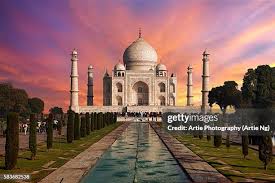The Taj Mahal: A Timeless Symbol of Love and Heritage

Introduction
The Taj Mahal, an iconic symbol of India’s rich history and cultural heritage, continues to attract millions of visitors each year. This magnificent mausoleum, located in Agra, was commissioned by Mughal Emperor Shah Jahan in memory of his beloved wife Mumtaz Mahal. As a UNESCO World Heritage Site, the Taj Mahal is not only a remarkable architectural achievement but also a testament to enduring love.
Historical Significance
Construction of the Taj Mahal began in 1632 and was completed in 1653, involving thousands of artisans and craftsmen from across the empire and beyond. The structure combines elements of Persian, Islamic, and Indian architectural styles, characterised by its stunning white marble façade and intricate inlay work. The central dome rises to a height of 35 metres, surrounded by symmetrical gardens, reflective pools, and additional buildings that contribute to its grandeur.
Recent Developments
In recent years, the Taj Mahal has faced numerous challenges, including environmental concerns and tourist management issues. Efforts to protect the monument from pollution have become urgent, as the marble surface has shown signs of discoloration due to air pollution in Agra. In response, authorities have restricted vehicular traffic near the site and have implemented cleaning processes to restore the marble’s original luster.
Moreover, the COVID-19 pandemic had a significant impact on tourism. Following the reopening of the monument in 2021, visitor numbers gradually increased, with special measures in place to ensure safety and compliance with health guidelines. By the end of 2022, the Taj Mahal welcomed over 6 million tourists, proving its status as one of the most visited heritage sites globally.
Conclusion
As the Taj Mahal stands as a beacon of India’s cultural legacy, its preservation and restoration are crucial for future generations. The monument not only serves as a reminder of Shah Jahan’s eternal love for Mumtaz Mahal but also represents the artistry and craftsmanship of the Mughal era. With ongoing conservation efforts and increased awareness of environmental issues, the Taj Mahal will continue to inspire awe and admiration for years to come, securing its place as a vital symbol of India’s rich history and heritage.








